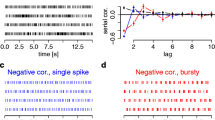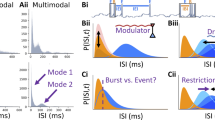Abstract
A lot of neurophysiological findings rely on accurate estimates of firing rates. In order to estimate an underlying rate function from sparse observations, i.e., spike trains, it is necessary to perform temporal smoothing over a short time window at each time point. In the empirical Bayes method, in which the assumption for the smoothness is incorporated in the Bayesian prior probability of underlying rate, the time scale of the temporal average, or the degree of smoothness, can be optimized by maximizing the marginal likelihood. Here, the marginal likelihood is obtained by marginalizing the complete-data likelihood over all possible latent rate processes. We carry out this marginalization using a path integral method. We show that there exists a lower bound of rate fluctuations below which the optimal smoothness parameter diverges. We also show that the optimal smoothness parameter obeys asymptotic scaling laws, the exponent of which depends on the smoothness of underlying rate processes.
Access this chapter
Tax calculation will be finalised at checkout
Purchases are for personal use only
Preview
Unable to display preview. Download preview PDF.
Similar content being viewed by others
References
Softky, W.R., Koch, C.: The Highly Irregular Firing of Cortical Cells Is Inconsistent with Temporal Integration of Random EPSPs. J. Neurosci. 13, 334–350 (1993)
Kass, R.E., Ventura, V., Brown, E.N.: Statistical Issues in the Analysis of Neuronal Data. J. Neurophysiol. 94, 8–25 (2005)
Shimazaki, H., Shinomoto, S.: A Method for Selecting the Bin Size of a Time Histogram. Neural Comp. 19, 1503–1700 (2007)
Bishop, C.M.: Pattern Recognition and Machine Learning. Springer (2006)
Cunningham, J.P., Yu, B.M., Shenoy, K.V., Sahani, M.: Inferring Neural Firing Rates from Spike Trains Using Gaussian Processes. In: Neural Information Processing Systems, vol. 20, pp. 329–336 (2008)
Koyama, S., Shinomoto, S.: Empirical Bayes Interpretations of Random Point Events. J. Phys. A: Math. Gen. 38, L531–L537 (2005)
Koyama, S., Shinomoto, S.: Phase Transitions in the Estimation of Event Rate: a Path Integral Analysis. J. Phys. A. Math. Theor. 40, F383–F390 (2007)
Coleman, S.: Aspects of Symmetry. Cambridge University Press (1988)
Kleinert, H.: Path Integrals in Quantum Mechanics, Statistics, Polymer Physics, and Financial Markets, 5th edn. World Scientific Publishing Company (2009)
Berman, M.: Inhomogeneous and Modulated Gamma Processes. Biometrica 68, 143–152 (1981)
Karatzas, I., Shreve, S.E.: Brownian Motion and Stochastic Calculus, 2nd edn. Springer (1997)
Ramsay, J., Silverman, B.W.: Functional Data Analysis, 2nd edn. Springer (2010)
Cox, D.R.: Renewal Theory. Chapman and Hall (1962)
Shintani, T., Shinomoto, S.: Detection Limit for Rate Fluctuations in Inhomogeneous Poisson Processes. Phys. Rev. E 85, 041139 (2012)
Koyama, S., Shinomoto, S.: Histogram Bin Width Selection for Time-Dependent Poisson Processes. J. Phys. A: Math. Gen. 37, 7255–7265 (2004)
Author information
Authors and Affiliations
Editor information
Editors and Affiliations
Rights and permissions
Copyright information
© 2012 Springer-Verlag Berlin Heidelberg
About this paper
Cite this paper
Koyama, S. (2012). Estimating Neural Firing Rates: An Empirical Bayes Approach. In: Huang, T., Zeng, Z., Li, C., Leung, C.S. (eds) Neural Information Processing. ICONIP 2012. Lecture Notes in Computer Science, vol 7664. Springer, Berlin, Heidelberg. https://doi.org/10.1007/978-3-642-34481-7_7
Download citation
DOI: https://doi.org/10.1007/978-3-642-34481-7_7
Publisher Name: Springer, Berlin, Heidelberg
Print ISBN: 978-3-642-34480-0
Online ISBN: 978-3-642-34481-7
eBook Packages: Computer ScienceComputer Science (R0)




